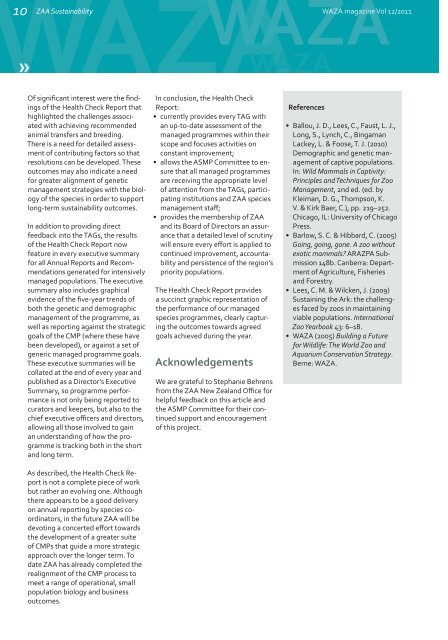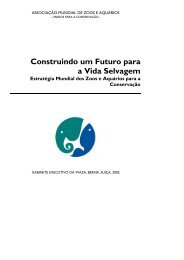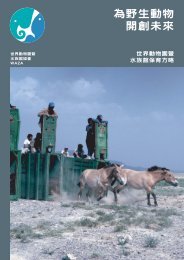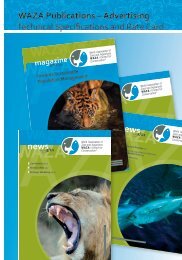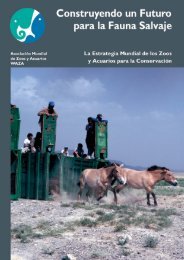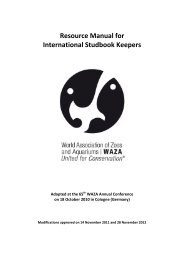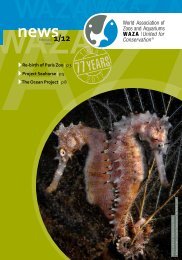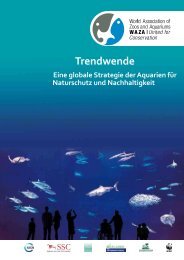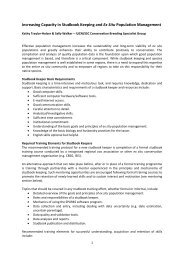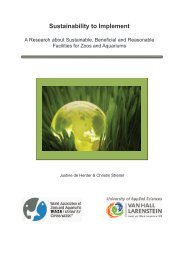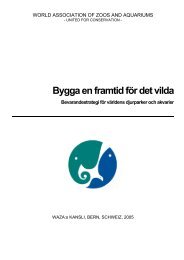Towards Sustainable Population Management - Waza
Towards Sustainable Population Management - Waza
Towards Sustainable Population Management - Waza
Create successful ePaper yourself
Turn your PDF publications into a flip-book with our unique Google optimized e-Paper software.
10 ZAA Sustainability<br />
WAZA magazine Vol 12/2011<br />
»<br />
Of significant interest were the findings<br />
of the Health Check Report that<br />
highlighted the challenges associated<br />
with achieving recommended<br />
animal transfers and breeding.<br />
There is a need for detailed assessment<br />
of contributing factors so that<br />
resolutions can be developed. These<br />
outcomes may also indicate a need<br />
for greater alignment of genetic<br />
management strategies with the biology<br />
of the species in order to support<br />
long-term sustainability outcomes.<br />
In addition to providing direct<br />
feedback into the TAGs, the results<br />
of the Health Check Report now<br />
feature in every executive summary<br />
for all Annual Reports and Recommendations<br />
generated for intensively<br />
managed populations. The executive<br />
summary also includes graphical<br />
evidence of the five-year trends of<br />
both the genetic and demographic<br />
management of the programme, as<br />
well as reporting against the strategic<br />
goals of the CMP (where these have<br />
been developed), or against a set of<br />
generic managed programme goals.<br />
These executive summaries will be<br />
collated at the end of every year and<br />
published as a Director’s Executive<br />
Summary, so programme performance<br />
is not only being reported to<br />
curators and keepers, but also to the<br />
chief executive officers and directors,<br />
allowing all those involved to gain<br />
an understanding of how the programme<br />
is tracking both in the short<br />
and long term.<br />
As described, the Health Check Report<br />
is not a complete piece of work<br />
but rather an evolving one. Although<br />
there appears to be a good delivery<br />
on annual reporting by species coordinators,<br />
in the future ZAA will be<br />
devoting a concerted effort towards<br />
the development of a greater suite<br />
of CMPs that guide a more strategic<br />
approach over the longer term. To<br />
date ZAA has already completed the<br />
realignment of the CMP process to<br />
meet a range of operational, small<br />
population biology and business<br />
outcomes.<br />
In conclusion, the Health Check<br />
Report:<br />
• currently provides every TAG with<br />
an up-to-date assessment of the<br />
managed programmes within their<br />
scope and focuses activities on<br />
constant improvement;<br />
• allows the ASMP Committee to ensure<br />
that all managed programmes<br />
are receiving the appropriate level<br />
of attention from the TAGs, participating<br />
institutions and ZAA species<br />
management staff;<br />
• provides the membership of ZAA<br />
and its Board of Directors an assurance<br />
that a detailed level of scrutiny<br />
will ensure every effort is applied to<br />
continued improvement, accountability<br />
and persistence of the region’s<br />
priority populations.<br />
The Health Check Report provides<br />
a succinct graphic representation of<br />
the performance of our managed<br />
species programmes, clearly capturing<br />
the outcomes towards agreed<br />
goals achieved during the year.<br />
Acknowledgements<br />
We are grateful to Stephanie Behrens<br />
from the ZAA New Zealand Office for<br />
helpful feedback on this article and<br />
the ASMP Committee for their continued<br />
support and encouragement<br />
of this project.<br />
References<br />
• Ballou, J. D., Lees, C., Faust, L. J.,<br />
Long, S., Lynch, C., Bingaman<br />
Lackey, L. & Foose, T. J. (2010)<br />
Demographic and genetic management<br />
of captive populations.<br />
In: Wild Mammals in Captivity:<br />
Principles and Techniques for Zoo<br />
<strong>Management</strong>, 2nd ed. (ed. by<br />
Kleiman, D. G., Thompson, K.<br />
V. & Kirk Baer, C.), pp. 219–252.<br />
Chicago, IL: University of Chicago<br />
Press.<br />
• Barlow, S. C. & Hibbard, C. (2005)<br />
Going, going, gone. A zoo without<br />
exotic mammals? ARAZPA Submission<br />
148b. Canberra: Department<br />
of Agriculture, Fisheries<br />
and Forestry.<br />
• Lees, C. M. & Wilcken, J. (2009)<br />
Sustaining the Ark: the challenges<br />
faced by zoos in maintaining<br />
viable populations. International<br />
Zoo Yearbook 43: 6–18.<br />
• WAZA (2005) Building a Future<br />
for Wildlife: The World Zoo and<br />
Aquarium Conservation Strategy.<br />
Berne: WAZA.


